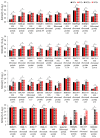Proteomics Reveals Distinct Changes Associated with Increased Gamma Radiation Resistance in the Black Yeast Exophiala dermatitidis
- PMID: 32992890
- PMCID: PMC7650708
- DOI: 10.3390/genes11101128
Proteomics Reveals Distinct Changes Associated with Increased Gamma Radiation Resistance in the Black Yeast Exophiala dermatitidis
Abstract
The yeast Exophiala dermatitidis exhibits high resistance to γ-radiation in comparison to many other fungi. Several aspects of this phenotype have been characterized, including its dependence on homologous recombination for the repair of radiation-induced DNA damage, and the transcriptomic response invoked by acute γ-radiation exposure in this organism. However, these findings have yet to identify unique γ-radiation exposure survival strategies-many genes that are induced by γ-radiation exposure do not appear to be important for recovery, and the homologous recombination machinery of this organism is not unique compared to more sensitive species. To identify features associated with γ-radiation resistance, here we characterized the proteomes of two E. dermatitidis strains-the wild type and a hyper-resistant strain developed through adaptive laboratory evolution-before and after γ-radiation exposure. The results demonstrate that protein intensities do not change substantially in response to this stress. Rather, the increased resistance exhibited by the evolved strain may be due in part to increased basal levels of single-stranded binding proteins and a large increase in ribosomal content, possibly allowing for a more robust, induced response during recovery. This experiment provides evidence enabling us to focus on DNA replication, protein production, and ribosome levels for further studies into the mechanism of γ-radiation resistance in E. dermatitidis and other fungi.
Keywords: black yeast; melanin; proteomics; radiobiology; translation.
Conflict of interest statement
The authors declare that no conflict of interest exist with regards to the information presented in this manuscript.
Figures






References
-
- LaVerne J.A. OH radicals and oxidizing products in the gamma radiolysis of water. Radiat. Res. 2000;153:196–200. - PubMed
-
- Lliakis G. The role of DNA double strand breaks in lonizing radiation—Induced killing of eukaryotic cells. Bioessays. 1991;13:641–648. - PubMed
-
- Resnick M.A. The repair of double-strand breaks in DNA: A model involving recombination. J. Theor. Biol. 1976;59:97–106. - PubMed
-
- Critchlow S.E., Jackson S.P. DNA end-joining: From yeast to man. Trends Biochem. Sci. 1998;23:394–398. - PubMed
-
- Daly M.J. Death by protein damage in irradiated cells. DNA Repair. 2012;11:12–21. - PubMed
Publication types
MeSH terms
Substances
Supplementary concepts
LinkOut - more resources
Full Text Sources

